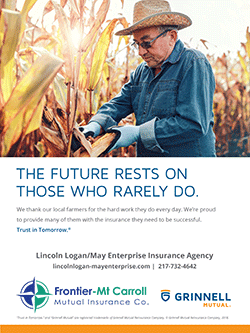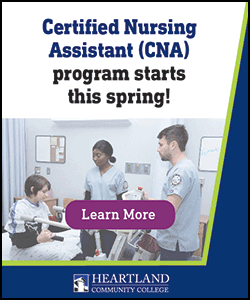|
 Agriculture continues to struggle with high costs and prices
that just do not want to go up to cover the higher costs of
farming. We do care and in lots of instances we can help. If you
think you are going to need a guaranteed or direct loan, please
come in and start that process with FSA now. Do not wait until
April if you think your finances need assistance now, sooner
would be better. Agriculture continues to struggle with high costs and prices
that just do not want to go up to cover the higher costs of
farming. We do care and in lots of instances we can help. If you
think you are going to need a guaranteed or direct loan, please
come in and start that process with FSA now. Do not wait until
April if you think your finances need assistance now, sooner
would be better.
As for farm programs Illinois FSA continues to work on the
Market Facilitation Program (MFP). Once again, Illinois FSA has
effectively delivered a program, issued payments to our
producers and provided essential resources to the Agricultural
Community.
In regards to a new Farm Bill; once the Farm Bill is passed, and
the new rules are implemented, the Illinois FSA State Office
will be trained by the National FSA Office, and in turn they
will train the County Office personnel. The FSA County Offices
will then have meetings for producers to be “trained”. Please
attend these meetings.
My best advice, do not wait until a program deadline to go into
an FSA office to sign up. Early is almost always better.
Enjoy the Holidays and we will see you again in 2019.
William Graff
State Executive Director
USDA Market Facilitation Program
Producers are urged to visit your local county FSA office and
sign CCC-910 to participate in MFP by close of business (COB),
Tuesday, January 15, 2019. If you have not yet completed
harvest, the CCC-910 MFP application is required to be on file
by COB January 15, 2019. There is no MFP application late filing
period. All producers have until May 1, 2019 to report 2018
harvested production.

USDA launched the trade mitigation package aimed at assisting
farmers suffering from damage due to unjustified trade
retaliation by foreign nations. Producers of certain commodities
can now sign up for the Market Facilitation Program (MFP).
USDA’s Farm Service Agency (FSA) is currently administering MFP
providing payments to corn, cotton, dairy, hog, sorghum,
soybean, wheat, shelled almond, and fresh sweet cherry
producers. An announcement about further payments will be made
in the coming months, if warranted.
The sign-up period for MFP runs through Jan. 15, 2019, with
information and instructions provided at www.farmers.gov/mfp.
Producers must apply for MFP, signing and submitting CCC-910 by
COB, Jan. 15, 2019. Eligible producers should apply after
harvest is complete, as MFP payments will only be issued once
production is reported and production must be reported by May
01, 2019.
A payment will be issued on 50 percent of the producer’s total
production, multiplied by the MFP rate for a specific commodity.
A second payment period, if warranted, will be determined by the
USDA.
FSA is currently approving and issuing MFP payments, in most
cases within a few days of a producer submitting production
evidence. Producers should submit their production in the year
they desire to receive the MFP payments, but by May 1, 2019.
MFP is designed to be a simple program – ONE application
containing ALL the 2018 production from ALL farms, ALL counties
and ALL states. Be sure to report all eligible bushels on one
application.
For a list of initial MFP payments rates, view the MFP Fact
Sheet.
MFP payments are capped per person or legal entity as follows:
-
A combined $125,000 for eligible crop commodities
-
A combined $125,000 for dairy production and hogs
-
A combined $125,000 for fresh sweet cherries and almonds
Applicants must also have an average adjusted gross income for
tax years 2014, 2015, and 2016 of less than $900,000. Applicants
must also comply with the provisions of the Highly Erodible Land
and Wetland Conservation regulations.
Expanded Hog Timeline
USDA has expanded the timeline for producers with whom the Aug.
1, 2018, date does not accurately represent the number of head
of live hogs they own. Producers may now choose any date between
July 15 to Aug. 15, 2018 that correctly reflects their actual
operation.
MFP applications are available online at www.farmers.gov/mfp.
Applications can be completed at a local FSA office or submitted
electronically either by scanning, emailing, or faxing. To
locate or contact your local FSA office, visit www.farmers.gov.
Loans for Targeted Underserved Producers
FSA has a number of loan programs available to assist applicants
to begin or continue in agriculture production. Loans are
available for operating type loans and/or to purchase or improve
farms or ranches.

While all qualified producers are eligible to apply for these
loan programs, FSA has provided priority funding for members of
targeted underserved applicants.
A targeted underserved applicant is one of a group whose members
have been subjected to racial, ethnic or gender prejudice
because of his or her identity as members of the group without
regard to his or her individual qualities.
For purposes of this program, targeted underserved groups are
women, African Americans, American Indians, Alaskan Natives,
Hispanics, Asian Americans and Pacific Islanders.
FSA loans are only available to applicants who meet all the
eligibility requirements and are unable to obtain the needed
credit elsewhere.
Farm Loan Graduation Reminder
FSA Direct Loans are considered a temporary source of credit
that is available to producers who do not meet normal
underwriting criteria for commercial banks.
FSA periodically conducts Direct Loan graduation reviews to
determine a borrower’s ability to graduate to commercial credit.
If the borrower’s financial condition has improved to a point
where they can refinance their debt with commercial credit, they
will be asked to obtain other financing and partially or fully
pay off their FSA debt.
By the end of a producer’s operating cycle, the Agency will send
a letter requesting a current balance sheet, actual financial
performance and a projected farm budget. The borrower has 30
days to return the required financial documents. This
information will be used to evaluate the borrower’s potential
for refinancing to commercial credit.
If a borrower meets local underwriting criteria, FSA will send
the borrower’s name, loan type, balance sheet and projected cash
flow to commercial lenders. The borrower will be notified when
loan information is sent to local lenders.
If any lenders are interested in refinancing the borrower’s
loan, FSA will send the borrower a letter with a list of lenders
that are interested in refinancing the loan. The borrower must
contact the lenders and complete an application for commercial
credit within 30 calendar days.
If a commercial lender rejects the borrower, the borrower must
obtain written evidence that specifies the reasons for rejection
and submit to their local FSA farm loan office.
If a borrower fails to provide the requested financial
information or to graduate, FSA will notify the borrower of
noncompliance, FSA’s intent to accelerate the loan, and appeal
rights.
2016, 2017 and 2018 Average Adjusted Gross Income (AGI)
Compliance Reviews
The AGI verification and compliance reviews for 2016, 2017 and
2018 are conducted on producers who the IRS indicated may have
exceeded the adjusted gross income limitations described in [7
CFR 1400.500]. Based on this review, producers will receive
determinations of eligibility or ineligibility.

If the producer is determined to have exceeded the average AGI
limitation of $900,000, receivables will be established for
payments earned directly or indirectly by the producer subject
to the $900,000 limitation. The State FSA Office continues to
notify producers selected for review. If you have any questions
about the review process or determinations, please contact the
Illinois State FSA Office at 217-241-6600. Producers who receive
initial debt notification letters may only appeal the amount of
the debt to their local FSA office. Payment eligibility adverse
determinations become administratively final 30 days from the
date of the payment eligibility adverse determination letter and
can only be reopened if exceptional circumstances exist that
prevented the producer from timely filing the appeal.
More information AGI can be found online at
https://www.fsa.usda.gov/
programs-and-services/payment-eligibility/adjusted-gross-income/index
Marketing Assistance Available for 2018 Crops
The 2014 Farm Bill authorized 2014-2018 crop year Marketing
Assistance Loans (MALs) and Loan Deficiency Payments (LDPs).
[to top of second column] |

MALs provide financing and marketing assistance for 2018 wheat,
as well as other commodities such as feed grains, soybeans and
other oilseeds, pulse crops, rice, wool and honey. MALs provide
producers interim financing after harvest to help them meet cash
flow needs without having to sell their commodities when market
prices are typically at harvest-time lows.
A producer who is eligible to obtain an MAL, but agrees to forgo
the loan, may obtain an LDP if such a payment is available.
To be eligible for an MAL or an LDP, producers must have a
beneficial interest in the commodity, in addition to other
requirements. A producer retains beneficial interest when
control of and title to the commodity is maintained. For an LDP,
the producer must retain beneficial interest in the commodity
from the time of planting through the date the producer filed
Form CCC-633EZ (page 1) in the FSA County Office. For more
information, producers should contact their local FSA county
office or view the LDP Fact Sheet.
USDA Acreage Reporting Deadline for Perennial Forage Changes
to July 15
USDA Farm Service Agency (FSA) has established a new acreage
reporting deadline for perennial forage for 2019 and subsequent
years. Previously set in the fall, the new deadline is July 15
for Illinois.
Timely and accurate acreage reports for all crops and land uses,
including prevented planting or failed acreage, are the
foundation for many FSA program benefits, including disaster
programs for livestock owners. Producers must report their
acreage to maintain program eligibility.
Producers who have coverage for perennial forage under the
Noninsured Crop Disaster Assistance Program (NAP) must report
their crop acreage by the earlier of any of the following:
-
the
established acreage reporting date (July 15)
-
15
calendar days before the onset of harvest or grazing of the
specific crop acreage being reported
-
the
established normal harvest date for the end of the coverage
period.
Permitted Revision of Intended use After Acreage Reporting
Date:
New operators or owners who pick up a farm after the acreage
reporting deadline has passed and the crop has already been
reported on the farm, have 30 days to change the intended use.
Producer share interest changes alone will not allow for
revisions to intended use after the acreage reporting date. The
revision must be performed by either the acreage reporting date
or within 30 calendar days from the date when the new operator
or owner acquired the lease on land, control of the land or
ownership and new producer crop share interest in the previously
reported crop acreage. Under this policy, appropriate
documentation must be provided to the County Committee’s
satisfaction to determine that a legitimate operator or
ownership and producer crop share interest change occurred to
permit the revision.
Definitions of Terms
FSA defines “idle” as cropland or a balance of cropland within a
Common Land Unit (CLU) (field/subfield) which is not planted or
considered not planted and does not meet the definition of
fallow or skip row. For example, the balance of a field that
could not be planted due to moisture or a turn area that is not
planted would be reported as idle.

Fallow is considered unplanted cropland acres which are part of
a crop/fallow rotation where cultivated land that is normally
planted is purposely kept out of production during a regular
growing season. Resting the ground in this manner allows it to
recover its fertility and conserve moisture for crop production
in the next growing season.
Tree Assistance Program (TAP) Sign-up
Orchardists and nursery tree growers who experience losses from
natural disasters during calendar year 2018 must submit a TAP
application either 90 calendar days after the disaster event or
the date when the loss is apparent. TAP was authorized by the
Agricultural Act of 2014 as a permanent disaster program. TAP
provides financial assistance to qualifying orchardists and
nursery tree growers to replant or rehabilitate eligible trees,
bushes and vines damaged by natural disasters.
Eligible tree types include trees, bushes or vines that produce
an annual crop for commercial purposes. Nursery trees include
ornamental, fruit, nut and Christmas trees that are produced for
commercial sale. Trees used for pulp or timber are ineligible.
To qualify for TAP, orchardists must suffer a qualifying tree,
bush or vine loss in excess of 15 percent mortality from an
eligible natural disaster, plus an adjustment for normal
mortality. The eligible trees, bushes or vines must have been
owned when the natural disaster occurred; however, eligible
growers are not required to own the land on which the eligible
trees, bushes and vines were planted.
If the TAP application is approved, the eligible trees, bushes
and vines must be replaced within 12 months from the date the
application is approved. The cumulative total quantity of acres
planted to trees, bushes or vines, for which a producer can
receive TAP payments, cannot exceed 500 acres annually.
Reporting Organic Crops
Producers who want to use the Noninsured Crop Disaster
Assistance Program (NAP) organic price and selected the
"organic" option on their NAP application must report their
crops as organic.
When certifying organic acres, the buffer zone acreage must be
included in the organic acreage.
Producers must also provide a current organic plan, organic
certificate or documentation from a certifying agent indicating
an organic plan is in effect. Documentation must include:
-
Name of certified individuals
-
Address
-
Telephone number
-
Effective date of certification
-
Certificate number
-
List of commodities certified
Name and address of certifying agent
-
A
map showing the specific location of each field of certified
organic, including the buffer zone acreage
Certification exemptions are available for producers whose
annual gross agricultural income from organic sales totals
$5,000 or less. Although exempt growers are not required to
provide a written certificate, they are still required to
provide a map showing the specific location of each field of
certified organic, transitional and buffer zone acreage.

For questions about reporting organic crops, contact your local
FSA office. To find your local office, visit http://offices.usda.gov.
Maintaining the Quality of Farm-Stored Loan Grain
Bins are ideally designed to hold a level volume of grain. When
bins are overfilled and grain is heaped up, airflow is hindered
and the chance of spoilage increases.
Producers who take out marketing assistance loans and use the
farm-stored grain as collateral should remember that they are
responsible for maintaining the quality of the grain through the
term of the loan.
Unauthorized Disposition of Grain
If loan grain has been disposed of through feeding, selling or
any other form of disposal without prior written authorization
from the county office staff, it is considered unauthorized
disposition. The financial penalties for unauthorized
dispositions are severe and a producer’s name will be placed on
a loan violation list for a two-year period. Always call before
you haul any grain under loan.
_small.png)
Click on image for larger version
Illinois Farm Service Agency
3500 Wabash Ave.
Springfield, IL 62711
Phone: 217-241-6600 Ext. 2
Fax: 855-800-1760
www.fsa.usda.gov/il
State Executive Director:
William J. Graff
State Committee:
James Reed-Chairperson
Melanie DeSutter-Member
George Obernagel III-Member
Troy Uphoff-Member
Executive Officer:
Rick Graden
Administrative Officer:
Dan Puccetti
Division Chiefs:
Doug Bailey
John Gehrke
Randy Tillman
To find contact information for your local office go to
www.fsa.usda.gov/il
USDA is an equal opportunity
provider, employer and lender. To file a complaint of
discrimination, write: USDA, Office of the Assistant Secretary for
Civil Rights, Office of Adjudication, 1400 Independence Ave., SW,
Washington, DC 20250-9410 or call (866) 632-9992 (Toll-free Customer
Service), (800) 877-8339 (Local or Federal relay), (866) 377-8642
(Relay voice users). |